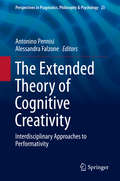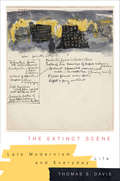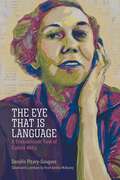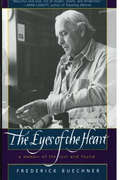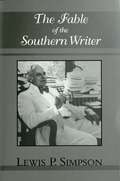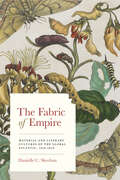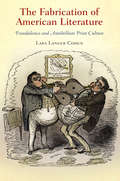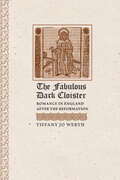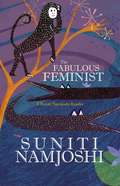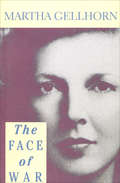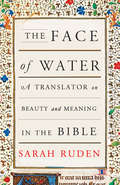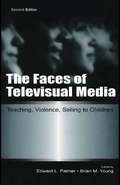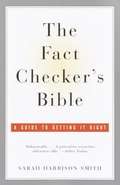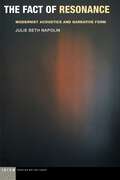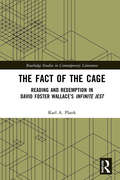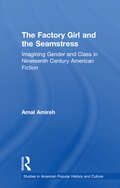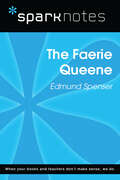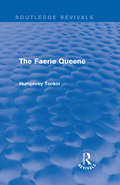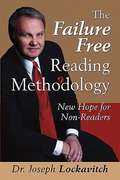- Table View
- List View
The Extended Theory of Cognitive Creativity: Interdisciplinary Approaches to Performativity (Perspectives in Pragmatics, Philosophy & Psychology #23)
by Antonino Pennisi Alessandra FalzoneThis edited volume focuses on the hypothesis that performativity is not a property confined to certain specific human skills, or to certain specific acts of language, nor an accidental enrichment due to creative intelligence. Instead, the executive and motor component of cognitive behavior should be considered an intrinsic part of the physiological functioning of the mind, and as endowed with self-generative power. Performativity, in this theoretical context, can be defined as a constituent component of cognitive processes. The material action allowing us to interact with reality is both the means by which the subject knows the surrounding world and one through which he experiments with the possibilities of his body. This proposal is rooted in models now widely accepted in the philosophy of mind and language; in fact, it focuses on a space of awareness that is not in the individual, or outside it, but is determined by the species-specific ways in which the body acts on the world. This theoretical hypothesis will be pursued through the latest interdisciplinary methodology typical of cognitive science, that coincide with the five sections in which the book is organized: Embodied, enactivist, philosophical approaches; Aesthetics approaches; Naturalistic and evolutionary approaches; Neuroscientific approaches; Linguistics approaches. This book is intended for: linguists, philosophers, psychologists, cognitive scientists, scholars of art and aesthetics, performing artists, researchers in embodied cognition, especially enactivists and students of the extended mind.
The Extinct Alphabet Book (Jerry Pallotta's Alphabet Books)
by Jerry PallottaLearn about the five-eyed Opabinia and the Four-toed Horse. Speculate about the life of the Jamaican Long-tongued Bat. Discover the fate of the beautiful Quagga. But don't look for any dinosaurs in this book. There aren't any!Millions of creatures other than dinosaurs are now extinct. In true alphabet book tradition, the author has found twenty-six of the most extraordinary past-inhabitants of the Earth.Jerry Pallotta and Ralph Masiello team up to provide exciting, accurate text and illustrations filled with unusual and amusing insight that will satisfy fans of all ages.
The Extinct Scene
by Thomas S. DavisIn 1935, the English novelist Stephen Spender wrote that the historical pressures of his era should "turn the reader's and writer's attention outwards from himself to the world." Combining historical, formalist, and archival approaches, Thomas S. Davis examines late modernism's decisive turn toward everyday life, locating in the heightened scrutiny of details, textures, and experiences an intimate attempt to conceptualize geopolitical disorder. The Extinct Scene reads a range of mid-century texts, films, and phenomena that reflect the decline of the British Empire and seismic shifts in the global political order. Davis follows the rise of documentary film culture and the British Documentary Film Movement, especially the work of John Grierson, Humphrey Jennings, and Basil Wright. He then considers the influence of late modernist periodical culture on social attitudes and customs, and, through a more nuanced understanding of the period, conducts original analyses of novels by Virginia Woolf, Christopher Isherwood, and Colin MacInnes; the interwar travel narratives of W. H. Auden, Christopher Isherwood, and George Orwell; the wartime gothic fiction of Elizabeth Bowen; the poetry of H. D.; the sketches of Henry Moore; and the postimperial Anglophone Caribbean works of Vic Reid, Sam Selvon, and George Lamming. By considering this varied group of writers, artists, and cultural leaders, Davis recasts late modernism as an art of scale: by detailing the particulars of everyday life, the movement could better project the large-scale undoing of history.
The Extinct Scene: Late Modernism and Everyday Life (Modernist Latitudes)
by Thomas DavisIn 1935, the English writer Stephen Spender wrote that the historical pressures of his era should "turn the reader's and writer's attention outwards from himself to the world." Combining historical, formalist, and archival approaches, Thomas S. Davis examines late modernism's decisive turn toward everyday life, locating in the heightened scrutiny of details, textures, and experiences an intimate attempt to conceptualize geopolitical disorder.The Extinct Scene reads a range of mid-century texts, films, and phenomena that reflect the decline of the British Empire and seismic shifts in the global political order. Davis follows the rise of documentary film culture and the British Documentary Film Movement, especially the work of John Grierson, Humphrey Jennings, and Basil Wright. He then considers the influence of late modernist periodical culture on social attitudes and customs, and presents original analyses of novels by Virginia Woolf, Christopher Isherwood, and Colin MacInnes; the interwar travel narratives of W. H. Auden, Christopher Isherwood, and George Orwell; the wartime gothic fiction of Elizabeth Bowen; the poetry of H. D.; the sketches of Henry Moore; and the postimperial Anglophone Caribbean works of Vic Reid, Sam Selvon, and George Lamming. By considering this group of writers and artists, Davis recasts late modernism as an art of scale: by detailing the particulars of everyday life, these figures could better project large-scale geopolitical events and crises.
The Extra Woman: How Marjorie Hillis Led A Generation Of Women To Live Alone And Like It
by Joanna ScuttsFrom the flapper to The Feminine Mystique, a cultural history of single women in the city through the reclaimed life of glamorous guru Marjorie Hillis. You’ve met the extra woman: she’s sophisticated, she lives comfortably alone, she pursues her passions unabashedly, and—contrary to society’s suspicions—she really is happy. Despite multiple waves of feminist revolution, today’s single woman is still mired in judgment or, worse, pity. But for a brief, exclamatory period in the late 1930s, she was all the rage. A delicious cocktail of cultural history and literary biography, The Extra Woman transports us to the turbulent and transformative years between suffrage and the sixties, when, thanks to the glamorous grit of one Marjorie Hillis, single women boldly claimed and enjoyed their independence. Marjorie Hillis, pragmatic daughter of a Brooklyn preacher, was poised for reinvention when she moved to the big city to start a life of her own. Gone were the days of the flirty flapper; ladies of Depression-era New York embraced a new icon: the independent working woman. Hillis was already a success at Vogue when she published a radical self-help book in 1936: Live Alone and Like It: A Guide for the Extra Woman. With Dorothy Parker–esque wit, she urged spinsters, divorcées, and “old maids” to shed derogatory labels and take control of their lives, and her philosophy became a phenomenon. From the importance of a peignoir to the joy of breakfast in bed (alone), Hillis’s tips made single life desirable and chic. In a style as irresistible as Hillis’s own, Joanna Scutts, a leading cultural critic, explores the revolutionary years following the Live-Alone movement, when the status of these “brazen ladies” peaked and then collapsed. Other innovative lifestyle gurus set similar trends that celebrated guiltless female independence and pleasure: Dorothy Draper’s interior design smash, Decorating Is Fun! transformed apartments; Irma Rombauer’s warm and welcoming recipe book, The Joy of Cooking, reassured the nervous home chef that she, too, was capable of decadent culinary feats. By painting the wider picture, Scutts reveals just how influential Hillis’s career was, spanning decades and numerous best sellers. As she refashioned her message with every life experience, Hillis proved that guts, grace, and perseverance would always be in vogue. With this vibrant examination of a remarkable life and profound feminist philosophy, Joanna Scutts at last reclaims Marjorie Hillis as the original queen of a maligned sisterhood. Channeling Hillis’s charm, The Extra Woman is both a brilliant exposé of women who forged their independent paths before the domestic backlash of the 1950s trapped them behind picket fences, and an illuminating excursion into the joys of fashion, mixology, decorating, and other manifestations of shameless self-love.
The Eye That Is Language: A Transatlantic View of Eudora Welty (Critical Perspectives on Eudora Welty)
by Danièle Pitavy-SouquesDanièle Pitavy-Souques (1937–2019) was a European powerhouse of Welty studies. In this collection of essays, Pitavy-Souques pours new light on Welty’s view of the world and her international literary import, challenging previous readings of Welty’s fiction, memoir, and photographs in illuminating ways. The nine essays collected here offer scholars, critics, and avid readers a new understanding and enjoyment of Welty’s work. The volume explores beloved stories in Welty’s masterpiece The Golden Apples, as well as “A Curtain of Green,” “Flowers for Marjorie,” “Old Mr. Marblehall,” “A Still Moment,” “Livvie,” “Circe,” “Kin,” and The Optimist’s Daughter, One Writer’s Beginnings, and One Time, One Place. Essays include “Technique as Myth: The Structure of The Golden Apples” (1979), “A Blazing Butterfly: The Modernity of Eudora Welty” (1987), and others written between 2000 and 2018. Together, they reveal and explain Welty’s brilliance for employing the particular to discover the universal. Pitavy-Souques, who briefly lived in and often revisited the South, met with Welty several times in her Jackson, Mississippi, home. Her readings draw on the visual arts, European theorists, and styles of modernism, postmodernism, surrealism, as well as the baroque and the gothic. The included essays reflect Pitavy-Souques’s European education, her sophisticated understanding of intellectual theories and artistic movements abroad, and her passion for the literary achievement of women of genius. The Eye That Is Language: A Transatlantic View of Eudora Welty reveals the way in which Welty’s narrative techniques broaden her work beyond southern myths and mysteries into a global perspective of humanity.
The Eye of the Story
by Eudora WeltyThe Eye of the Story is a priceless collection of essays. A lot of informative aspects of writing with reference to great writers like Jane Austen, Virginia Woolf and many others have been included in this book.
The Eyes of the Heart: A Memoir of the Lost and Found
by Frederick BuechnerFrom critically acclaimed author and Pulitzer Prize runner-up Frederick Buechner comes another powerfully honest memoir, The Eyes of the Heart. Full of poinant insights into his most personal relationships, this moving account traces how the author was shaped as much by his family's secrets as by its celebrations.Within the innermost chambers of his consciousness, Buechner, in his characteristically self-searching style, explores the mysteries and truths behind his deepest connections to family, friends, and mentors. Extraordinarily moving, this memoir follows not chronology but the converging paths of Buechner's imagination and memory.Buechner invites us into his library-his own Magic Kingdom, Surrounded by his beloved books and treasures, we discover how they serve as the gateway to Buechner's mind and heart. He draws the reader into his recollections, moving seamlessly from reminiscence to contemplation. Buechner recounts events such as the tragic suicide of his father and its continual fallout on his life, intimate and little-known details about his deep friendship with the late poet James Merrill, and his ongoing struggle to understand the complexities of his relationship to his mother.This cast of characters comprised of Buechner's relatives and loved ones is brought to vibrant life by his peerless writing and capacity to probe the depths of his own consciousness. Buechner visits his past with an honest eye and a heart open to the most painful and life-altering of realizations. heartbreaking and enlightening, The Eyes of the Heart is a treasure for any who have ever pondered the meaning and mystery of their own past.As "one of our finest writers," according to author Annie Dillard, Frederick Buechner provides yet another chapter in the tale of his life in this gripping memoir tracing the complicated roots and path of his inner life and family, with their multitude of intersections." The Eyes of the Heart stands as a touching testimonial to the significance of kinship to the author as well as to the legions of readers who have come to regard him as one of their own.
The Fable of the Southern Writer
by Lewis P. Simpson"With a breadth and depth unsurpassed by any other cultural historian of the South, Lewis Simpson examines the writing of southerners Thomas Jefferson, John Randolph, Mark Twain, Robert Penn Warren, Allen Tate, William Faulkner, Elizabeth Madox Roberts, Arthur Crew Inman, William Styron, and Walker Percy. Simpson offers challenging essays of easy erudition blessedly free of academic jargon.... [They] do not propose to support an overall thesis, but simply explore the southern writer's unique relationship with his or her region, bereft of myth and tradition, in the grasp of science and history." -- Library Journal
The Fabric of Empire: Material and Literary Cultures of the Global Atlantic, 1650-1850 (Studies in Early American Economy and Society from the Library Company of Philadelphia)
by Danielle C. SkeehanRevealing the entangled lives of texts and textiles in the early modern Atlantic world."Textiles are the books that the colony was not able to burn."—Asociación Femenina para el Desarrollo de Sacatepéquez (AFEDES)A history of the book in the Americas, across deep time, would reveal the origins of a literary tradition woven rather than written. It is in what Danielle Skeehan calls material texts that a people's history and culture is preserved, in their embroidery, their needlework, and their woven cloth. In defining textiles as a form of cultural writing, The Fabric of Empire challenges long-held ideas about authorship, textuality, and the making of books. It is impossible to separate text from textiles in the early modern Atlantic: novels, newspapers, broadsides, and pamphlets were printed on paper made from household rags. Yet the untethering of text from textile served a colonial agenda to define authorship as reflected in ink and paper and the pen as an instrument wielded by learned men and women. Skeehan explains that the colonial definition of the book, and what constituted writing and authorship, left colonial regimes blind to nonalphabetic forms of media that preserved cultural knowledge, history, and lived experience. This book shifts how we look at cultural objects such as books and fabric and provides a material and literary history of resistance among the globally dispossessed.Each chapter examines the manufacture and global circulation of a particular type of cloth alongside the complex print networks that ensured the circulation of these textiles, promoted their production, petitioned for or served to curtail the rights of textile workers, facilitated the exchange of textiles for human lives, and were, in turn, printed and written on surfaces manufactured from broken-down linen and cotton fibers. Bringing together methods and materials traditionally belonging to literary studies, book history, and material culture studies, The Fabric of Empire provides a new model for thinking about the different media, languages, literacies, and textualities in the early Atlantic world.
The Fabrication of American Literature
by Lara Langer CohenLiterary histories typically celebrate the antebellum period as marking the triumphant emergence of American literature. But the period's readers and writers tell a different story: they derided literature as a fraud, an imposture, and a humbug, and they likened it to inflated currency, land bubbles, and quack medicine.Excavating a rich archive of magazine fiction, verse satires, comic almanacs, false slave narratives, minstrel song sheets, and early literary criticism, and revisiting such familiar figures as Edgar Allan Poe, Davy Crockett, Fanny Fern, and Herman Melville, Lara Langer Cohen uncovers the controversies over literary fraudulence that plagued these years and uses them to offer an ambitious rethinking of the antebellum print explosion. She traces the checkered fortunes of American literature from the rise of literary nationalism, which was beset by accusations of puffery, to the conversion of fraudulence from a national dilemma into a sorting mechanism that produced new racial, regional, and gender identities. Yet she also shows that even as fraudulence became a sign of marginality, some authors managed to turn their dubious reputations to account, making a virtue of their counterfeit status. This forgotten history, Cohen argues, presents a dramatically altered picture of American literature's role in antebellum culture, one in which its authority is far from assured, and its failures matter as much as its achievements.
The Fabulous Dark Cloister: Romance in England after the Reformation
by Tiffany J. WerthRomances were among the most popular books in the sixteenth and seventeenth centuries among both Protestant and Catholic readers. Modeled after Catholic narratives, particularly the lives of saints, these works emphasized the supernatural and the marvelous, themes commonly associated with Catholicism. In this book, Tiffany Jo Werth investigates how post-Reformation English authors sought to discipline romance, appropriating its popularity while distilling its alleged Catholic taint. Charged with bewitching readers, especially women, into lust and heresy, romances sold briskly even as preachers and educators denounced them as papist. Protestant reformers, as part of their broader indictment of Catholicism, sought to redirect certain elements of the Christian tradition, including this notorious literary genre. Werth argues that through the writing and circulation of romances, Protestants repurposed their supernatural and otherworldly motifs in order to "fashion," as Edmund Spenser wrote, godly "vertuous" readers. Through careful examinations of the period’s most renowned romances—Sir Philip Sidney’s The Countess of Pembrokes Arcadia, Spenser’s The Faerie Queen, William Shakespeare’s Pericles, and Lady Mary Wroth’s Urania—Werth illustrates how post-Reformation writers struggled to transform the literary genre. As a result, the romance, long regarded as an archetypal form closely allied with generalized Christian motifs, emerged as a central tenet of the religious controversies that divided Renaissance England.
The Fabulous Feminist
by Suniti NamjoshiIt was on a sabbatical in England in the late seventies that Suniti Namjoshi discovered feminism-or rather, she discovered that other feminists existed, and many among them shared her thoughts and doubts, her questions and visions. Since then, she has been writing-fables, poetry, prose autobiography, children's stories-about power, about inequality, about oppression, effectively using the power of language and the literary tradition to expose what she finds absurd and unacceptable. This new collection brings together in one volume a huge range of Namjoshi's writings, starting with her classic collection, Feminist Fables, and coming right up to her latest work.
The Fabulous Imagination: On Montaigne's Essays
by Lawrence D. KritzmanThis is one of the few books on Montaigne that fuses analytical skill with humane awareness of why Montaigne matters. Harold Bloom, Sterling Professor of Humanities, Yale University; In this exhilarating and learned book on Montaigne's essays, Lawrence D. Kritzman contemporizes the great writer. Reading him from today's deconstructive America, Kritzman discovers Montaigne always already deep into a dialogue with Jacques Derrida and psychoanalysis. One cannot but admire this fabulous act of translation. -Helene Cixous Throughout his career, Lawrence D. Kritzman has demonstrated an intimate knowledge of Montaigne's essays and an engagement with French philosophy and critical theory. The Fabulous Imagination sheds precious new light on one of the founders of modern individualism and on his crucial quest for self-knowledge. -Jean Starobinski, professor emeritus of French literature, University of Geneva Michel de Montaigne's (1533-1592) Essais was a profound study of human subjectivity. More than three hundred years before the advent of psychoanalysis, Montaigne embarked on a remarkable quest to see and imagine the self from a variety of vantages. Through the questions How shall I live? How can I know myself? he explored the significance of monsters, nightmares, and traumatic memories; the fear of impotence; the fragility of gender; and the act of anticipating and coping with death. In this book, Lawrence D. Kritzman traces Montaigne's development of the Western concept of the self. For Montaigne, imagination lies at the core of an internal universe that influences both the body and the mind. Imagination is essential to human experience. Although Montaigne recognized that the imagination can confuse the individual, "the fabulous imagination" can be curative, enabling the mind's "I" to sustain itself in the face of hardship. Kritzman begins with Montaigne's study of the fragility of gender and its relationship to the peripatetic movement of a fabulous imagination. He then follows with the essayist's examination of the act of mourning and the power of the imagination to overcome the fear of death. Kritzman concludes with Montaigne's views on philosophy, experience, and the connection between self-portraiture, ethics, and oblivion. His reading demonstrates that the mind's I, as Montaigne envisioned it, sees by imagining that which is not visible, thus offering an alternative to the logical positivism of our age.
The Fabulous Imagination: On Montaigne's Essays
by Lawrence D. Kritzman"This is one of the few books on Montaigne that fuses analytical skill with humane awareness of why Montaigne matters."-Harold Bloom, Sterling Professor of Humanities, Yale University"In this exhilarating and learned book on Montaigne's essays, Lawrence D. Kritzman contemporizes the great writer. Reading him from today's deconstructive America, Kritzman discovers Montaigne always already deep into a dialogue with Jacques Derrida and psychoanalysis. One cannot but admire this fabulous act of translation."-Hélène Cixous"Throughout his career, Lawrence D. Kritzman has demonstrated an intimate knowledge of Montaigne's essays and an engagement with French philosophy and critical theory. The Fabulous Imagination sheds precious new light on one of the founders of modern individualism and on his crucial quest for self-knowledge."-Jean Starobinski, professor emeritus of French literature, University of GenevaMichel de Montaigne's (1533-1592) Essais was a profound study of human subjectivity. More than three hundred years before the advent of psychoanalysis, Montaigne embarked on a remarkable quest to see and imagine the self from a variety of vantages. Through the questions How shall I live? How can I know myself? he explored the significance of monsters, nightmares, and traumatic memories; the fear of impotence; the fragility of gender; and the act of anticipating and coping with death. In this book, Lawrence D. Kritzman traces Montaigne's development of the Western concept of the self. For Montaigne, imagination lies at the core of an internal universe that influences both the body and the mind. Imagination is essential to human experience. Although Montaigne recognized that the imagination can confuse the individual, "the fabulous imagination" can be curative, enabling the mind's "I" to sustain itself in the face of hardship. Kritzman begins with Montaigne's study of the fragility of gender and its relationship to the peripatetic movement of a fabulous imagination. He then follows with the essayist's examination of the act of mourning and the power of the imagination to overcome the fear of death. Kritzman concludes with Montaigne's views on philosophy, experience, and the connection between self-portraiture, ethics, and oblivion. His reading demonstrates that the mind's I, as Montaigne envisioned it, sees by imagining that which is not visible, thus offering an alternative to the logical positivism of our age.
The Face of War: Writings From The Frontline, 1937-1985
by Martha GellhornMartha Gellhorn (1908–1998) was a war correspondent for nearly fifty years. From the Spanish Civil War in 1937 through the wars in Central America in the mid-eighties, her candid reports reflected her feelings for people no matter what their political ideologies, and the openness and vulnerability of her conscience. I wrote very fast, as I had to,” she says, afraid that I would forget the exact sound, smell, words, gestures, which were special to this moment and this place.” Whether in Java, Finland, the Middle East, or Vietnam, she used the same vigorous approach. Collected here together for the first time, The Face of War is what The New York Times called a brilliant anti-war book.”
The Face of Water: A Translator on Beauty and Meaning in the Bible
by Sarah RudenA dazzling reconsideration of the original languages and texts of the Bible, in both the Old and the New Testaments, from the acclaimed scholar and translator of Classical literature (“The best translation of the Aeneid, certainly the best of our time” —Ursula Le Guin; “The first translation since Dryden that can be read as a great English poem in itself” —Garry Wills, The New York Review of Books) and author of Paul Among the People (“Astonishing . . . Superb” —Booklist, starred review). In The Face of Water, Sarah Ruden brilliantly and elegantly explains and celebrates the Bible’s writings. Singling out the most famous passages, such as the Genesis creation story, the Ten Commandments, the Lord’s Prayer, and the Beatitudes, Ruden reexamines and retranslates from the Hebrew and Greek what has been obscured and misunderstood over time. Making clear that she is not a Biblical scholar, cleric, theologian, or philosopher, Ruden—a Quaker—speaks plainly in this illuminating and inspiring book. She writes that while the Bible has always mattered profoundly, it is a book that in modern translations often lacks vitality, and she sets out here to make it less a thing of paper and glue and ink and more a live and loving text. Ruden writes of the early evolution, literary beauty, and transcendent ideals of the Hebrew Bible and the Greek New Testament, exploring how the Jews came to establish the greatest, most enduring book on earth as their regional strategic weakness found a paradoxical moral and spiritual strength through their writings, and how the Christians inherited and adapted this remarkable literary tradition. She writes as well about the crucial purposes of translation, not only for availability of texts but also for accountability in public life and as a reflection of society’s current concerns. She shows that it is the original texts that most clearly reveal our cherished values (both religious and secular), unlike the standard English translations of the Bible that mask even the yearning for freedom from slavery. The word “redemption” translated from Hebrew and Greek, meaning mercy for the exploited and oppressed, is more abstract than its original meaning—to buy a person back from captivity or slavery or some other distress. The Face of Water is as much a book about poetry, music, drama, raw humor, and passion as it is about the idealism of the Bible. Ruden’s book gives us an unprecedented, nuanced understanding of what this extraordinary document was for its earliest readers and what it can still be for us today
The Faces of Televisual Media: Teaching, Violence, Selling To Children (Routledge Communication Series)
by EDWARD L.PALMER and BRIAN M.YOUNGThis collection offers original, state-of-the-art contributions from leading authorities in children's televisual media. International researchers from communication and psychology provide readers with ready access to current televisual research, trends, and policymaking/political climate issues pertaining to children. This second edition provides a current summary of studies on content, viewing patterns, comprehension, effects, and individual differences in instructional and educational programming, televisual entertainment and violence programming, and televisual advertising to children. Editors Edward L. Palmer and Brian M. Young have structured the volume into three sections examining the "faces" of television: the Teaching (instructional/educational) Face, the Violent Face, and the Selling (advertising) Face. Chapters within each section identify and focus recurrent themes while integrating them topically into a coherent whole. Each area incorporates new technologies and considers their potentials, effects, and future. Subjects featured in the various chapters include: *cross-cultural and historical comparisons with an in-depth perspective on the BBC and other European/Asian televisual media roots, as well as America's formative televisual media roots; *an examination of key differences between developed and developing countries; *implications of emerging instructional/educational media for children's education--addressing both cognitive and multi-ethnic aspects; and * prominent, informed challenge to the prevailing popular view that children are unaffected and unharmed by exposure to media violence. This volume informs ongoing debates across a broad spectrum of current, critical issues, and suggests avenues for future research. It is pertinent and provocative for the most sophisticated scholar in the field, as well as for students in areas of developmental or social psychology, communication, education, sociology, marketing, broadcasting and film, public policy, advertising, and medicine/pediatrics. It is also appropriate for courses in children, media, and society.
The Fact Checker's Bible: A Guide to Getting It Right
by Sarah Harrison SmithThe first book of its kind,The Fact Checker’s Bibleis the essential guide to the important but often neglected task of checking facts, whatever their source. Today, everyone is overwhelmed with information that claims to be factual. But even the most punctilious researcher, writer, student or journalist--not to mention the lazy or deliberately mendacious ones--can sometimes get it wrong. So checking facts has become a more pressing task. But how to go about it? The Fact Checker’s Biblecovers: *Reading for accuracy *Determining what to check *Researching the facts *Assessing sources: people, newspapers and magazines, books, the Internet, etc. *Checking quotations *Understanding the legal liabilities of getting it wrong *Looking out for and avoiding the dangers of plagiarism For everyone from students to editors to journalists, the methods and practices outlined inThe Fact Checker’s Bibleprovides both a standard and a working manual for how to get the facts right. From the Trade Paperback edition.
The Fact of Resonance: Modernist Acoustics and Narrative Form (Idiom: Inventing Writing Theory)
by Julie Beth NapolinShortlisted, 2021 Memory Studies Association First Book AwardThe Fact of Resonance returns to the colonial and technological contexts in which theories of the novel developed, seeking in sound an alternative premise for theorizing modernist narrative form. Arguing that narrative theory has been founded on an exclusion of sound, the book poses a missing counterpart to modernism’s question “who speaks?” in the hidden acoustical questions “who hears?” and “who listens?”For Napolin, the experience of reading is undergirded by the sonic. The book captures and enhances literature’s ambient sounds, sounds that are clues to heterogeneous experiences secreted within the acoustical unconscious of texts. The book invents an oblique ear, a subtle and lyrical prose style attuned to picking up sounds no longer hearable. “Resonance” opens upon a new genealogy of modernism, tracking from Joseph Conrad to his interlocutors—Sigmund Freud, Frantz Fanon, W. E. B. Du Bois, William Faulkner, and Chantal Akerman—the racialized, gendered, and colonial implications of acoustical figures that “drift” through and are transformed by narrative worlds in writing, film, and music.A major synthesis of resources gleaned from across the theoretical humanities, the book argues for “resonance” as the traversal of acoustical figures across the spaces of colonial and technological modernity, figures registering and transmitting transformations of “voice” and “sound” across languages, culture, and modalities of hearing. We have not yet sufficiently attended to relays between sound, narrative, and the unconscious that are crucial to the ideological entailments and figural strategies of transnational, transatlantic, and transpacific modernism. The breadth of the book’s engagements will make it of interest not only to students and scholars of modernist fiction and sound studies, but to anyone interested in contemporary critical theory.
The Fact of the Cage: Reading and Redemption In David Foster Wallace’s "Infinite Jest" (Routledge Studies in Contemporary Literature)
by Karl A. PlankDavid Foster Wallace’s Infinite Jest raised expectations of what a novel might do. As he understood fiction to aim at what it means to be human, so he hoped his work might relieve the loneliness of human suffering. In that light, The Fact of the Cage shows how Wallace’s masterpiece dramatizes the condition of encagement and how it comes to be met by "Abiding" and through inter-relational acts of speaking and hearing, touching, and facing. Revealing Wallace’s theology of a "boneless Christ," The Fact of the Cage wagers that reading such a novel as Infinite Jest makes available to readers the redemption glimpsed in its pages, that reading fiction has ethical and religious significance—in short, that reading Infinite Jest makes one better. As such, Plank’s work takes steps to defend the ethics of fiction, the vital relation between religion and literature, and why one just might read at all.
The Factory Girl and the Seamstress: Imagining Gender and Class in Nineteenth Century American Fiction (Studies in American Popular History and Culture)
by Amal AmirehThis book studies the representations of working-class women in canonical and popular American fiction between 1820 and 1870. These representations have been invisible in nineteenth century American literary and cultural studies due to the general view that antebellum writers did not engage with their society's economic and social relaities. Against this view and to highlight the cultural importance of working-class women, this study argues that, in responding to industrialization, middle class writers such as Melville, Hawthorne, Fern, Davies, and Phelps used the figures of the factory worker and the seamstress to express their anxieties about unstable gender and class identitites. These fictional representations were influenced by, and contributed to, an important but understudied cultural debate about wage labor, working women, and class.
The Faerie Queen (SparkNotes Literature Guide Series)
by SparkNotesThe Faerie Queen (SparkNotes Literature Guide) by Edmund Spenser Making the reading experience fun! Created by Harvard students for students everywhere, SparkNotes is a new breed of study guide: smarter, better, faster.Geared to what today's students need to know, SparkNotes provides:chapter-by-chapter analysis explanations of key themes, motifs, and symbols a review quiz and essay topics Lively and accessible, these guides are perfect for late-night studying and writing papers.
The Faerie Queene (Routledge Revivals)
by Humphrey TonkinEdmund Spenser’s The Faerie Queene is among the most important literary products of the Elizabethan age, and the vast sweep of its moral, political and social concerns tells us more about the age than any other work. This volume, first published in 1989, offers detailed readings of each of the poem’s seven books, along with introductory chapters on Spenser’s career, and the roots of the poem in the English and continental traditions. Humphrey Tonkin pays particular attention to the work’s political and cultural role and its contribution to the development of Elizabethan ideology. A comprehensive analysis, this reissue will be of particular value to literature students and academics alike.
The Failure Free Reading Methodology: New Hope for Non-readers
by Joseph LockavitchThis book provides the insight into a new corrective reading action. The time has come to stop giving up on failing students and this book shows how.
